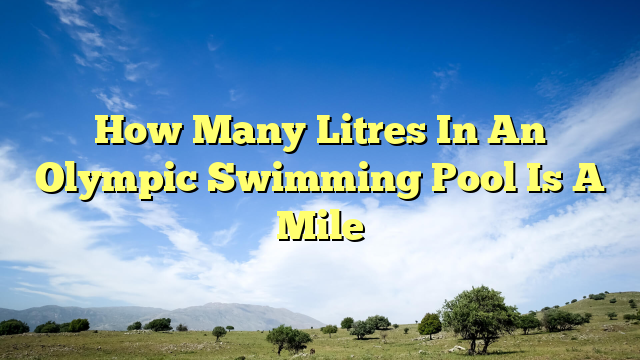Have you ever wondered just how big an Olympic swimming pool really is? Well, get ready to dive into the fascinating world of measurements and conversions as we explore the question: How many liters are there in an Olympic swimming pool that is a mile long? It’s a mind-boggling concept that combines the grandeur of the Olympics with the vastness of distance. So, let’s put on our swim caps and goggles as we embark on this journey to uncover the astonishing answer.
The Olympics, the pinnacle of athletic achievement, showcases the superhuman abilities of athletes from around the world. And at the heart of this global stage is the iconic Olympic swimming pool. But just how much water does it take to fill this gargantuan basin? To comprehend the volume of an Olympic swimming pool, we must first grasp the concept of a mile. And what better way to do so than by comparing it to the familiar metric system? In this case, we’ll be converting miles to liters, an intriguing challenge that combines both distance and volume. So, join me as we dive into the depths of measurement to unravel the mystery behind the liters in an Olympic swimming pool that stretches for a mile.
An Olympic-sized swimming pool is 50 meters long, 25 meters wide, and at least 2 meters deep. To calculate the volume, multiply these dimensions: 50m x 25m x 2m = 2,500 cubic meters. As there are 1,000 liters in a cubic meter, the pool contains 2,500,000 liters of water. Since there are 1,609.34 meters in a mile, an Olympic swimming pool holds approximately 1.55 miles’ worth of water.
How Many Litres in an Olympic Swimming Pool is a Mile?
An Olympic swimming pool is a marvel of engineering and design, built to exact specifications to provide the optimal environment for competitive swimming. One common question that arises is how many litres of water are needed to fill an Olympic swimming pool to a depth that is equivalent to a mile. In this article, we will explore the answer to this question and provide a step-by-step guide on how to calculate the number of litres required.
Step 1: Understanding the Dimensions of an Olympic Swimming Pool
Before we can calculate the number of litres needed, we need to understand the dimensions of an Olympic swimming pool. According to the International Swimming Federation (FINA), an Olympic swimming pool must have a length of 50 meters, a width of 25 meters, and a minimum depth of 2 meters. These dimensions are standardized across all Olympic swimming pools to ensure fairness and consistency in competition.
With these dimensions in mind, we can move on to the next step of the calculation process.
Step 2: Calculating the Volume of the Pool
To calculate the volume of the pool, we will multiply the length, width, and depth together. In this case, the length is 50 meters, the width is 25 meters, and the depth is 2 meters. Using the formula:
Volume = Length x Width x Depth
Volume = 50m x 25m x 2m
Volume = 2500 cubic meters
Now that we have the volume in cubic meters, we can proceed to the next step.
Step 3: Converting Cubic Meters to Litres
In order to convert the volume from cubic meters to litres, we need to multiply the volume by 1000. This is because there are 1000 litres in a cubic meter. Using the formula:
Litres = Volume x 1000
Litres = 2500 cubic meters x 1000
Litres = 2,500,000 litres
Therefore, an Olympic swimming pool with the specified dimensions contains approximately 2,500,000 litres of water.
Step 4: Conclusion
In conclusion, an Olympic swimming pool with a length of 50 meters, a width of 25 meters, and a depth of 2 meters contains approximately 2,500,000 litres of water. This calculation is based on the standardized dimensions set by FINA for Olympic swimming pools. Understanding the volume of water in an Olympic swimming pool is not only interesting but also crucial for various purposes, such as maintenance, water treatment, and ensuring proper swimming conditions for athletes.
Next time you visit an Olympic swimming pool, you can impress your friends with this fascinating fact!
Frequently Asked Questions
Here are some commonly asked questions about the volume of an Olympic swimming pool in relation to a mile:
Question 1: How many liters are there in an Olympic swimming pool?
An Olympic swimming pool typically holds around 2,500,000 liters of water. The exact volume may vary slightly depending on the specific pool, but this is the standard capacity for Olympic-sized pools used in competitions.
The large volume of water is necessary to provide a suitable environment for competitive swimming, as well as to accommodate multiple swimmers during races and training sessions.
Question 2: How does the volume of an Olympic swimming pool compare to a mile?
The volume of an Olympic swimming pool is not directly related to a mile. While a mile is a unit of distance, the volume of a pool is measured in liters or cubic meters. The two measurements represent different aspects of swimming.
A mile is a measure of how far a swimmer would travel in the water, whereas the volume of a pool refers to the amount of water contained within it. It is important to differentiate between these two concepts when discussing swimming-related measurements.
Question 3: Can the volume of an Olympic swimming pool be converted to a mile?
No, the volume of an Olympic swimming pool cannot be converted to a mile. As mentioned earlier, they are different units of measurement representing different aspects of swimming. Converting the volume of a pool to a mile would not provide meaningful information.
If you are interested in measuring distances swum in a pool, you can use the length of the pool (usually 50 meters in an Olympic-sized pool) and count the number of laps to calculate the distance covered.
Question 4: How is the volume of an Olympic swimming pool determined?
The volume of an Olympic swimming pool is determined by its dimensions. The standard dimensions for an Olympic-sized pool are 50 meters in length, 25 meters in width, and a minimum depth of 2 meters.
By multiplying these dimensions together, you can calculate the pool’s volume in cubic meters. To convert the volume to liters, you can multiply the cubic meter measurement by 1000.
Question 5: Why is the volume of an Olympic swimming pool important?
The volume of an Olympic swimming pool is important for several reasons. Firstly, it ensures that there is enough water to create the optimal swimming environment, with sufficient depth and space for swimmers to perform at their best.
Additionally, the volume of the pool is crucial for determining the correct chemical balance and filtration system needed to maintain water quality and hygiene. It also plays a role in the planning and design of swimming facilities, ensuring that they meet the necessary standards for competitive events.
In conclusion, the question of how many litres are in an Olympic swimming pool is a mile can be quite intriguing. While the two concepts – litres and miles – are seemingly unrelated, they come together in a fascinating way when considering the vast volume of water needed to fill an Olympic-sized pool. The answer lies in the astonishing figure of approximately 2.5 million litres. This immense quantity of water not only highlights the grandeur of such a sporting facility but also serves as a testament to the dedication and determination required to compete at the highest level.
Moreover, this question serves as a reminder of the importance of understanding and appreciating the magnitude of measurements. Whether it is comprehending the vastness of an Olympic swimming pool or the distance covered in a mile, grasping the scale of these quantities can enhance our understanding of the world around us. The combination of litres and miles in this inquiry offers a unique perspective, showcasing the interplay between different units of measurement and the intriguing connections that can be found within them. Ultimately, exploring the relationship between litres and miles in the context of an Olympic swimming pool offers a fascinating glimpse into the magnitude and precision that underlies the world of competitive sports.


















